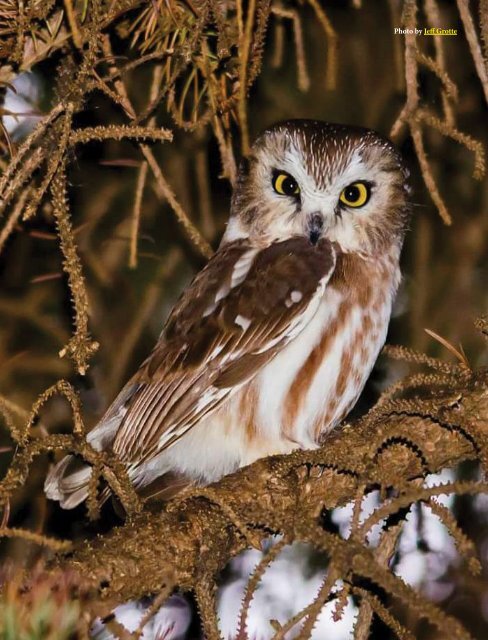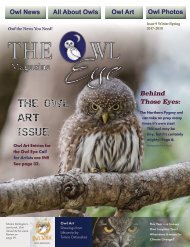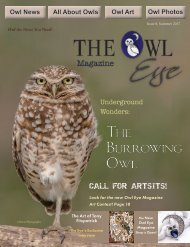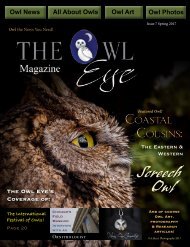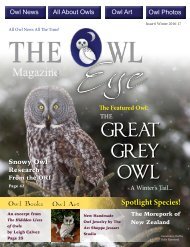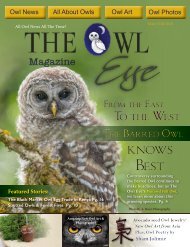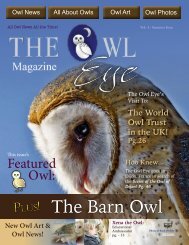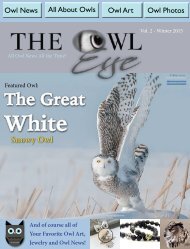The Owl Eye Spring 2016
Here is the new Owl Eye Issue 3 for Spring. This issue features the Owl Eye's account of the International Festival of Owls, March, 2016.
Here is the new Owl Eye Issue 3 for Spring. This issue features the Owl Eye's account of the International Festival of Owls, March, 2016.
Create successful ePaper yourself
Turn your PDF publications into a flip-book with our unique Google optimized e-Paper software.
Photo by Jeff Grotte<br />
Hunting & Food: <strong>The</strong>se <strong>Owl</strong>s hunt mainly at dusk and dawn and most often use the "sit and wait" tactic<br />
to drop down onto prey on the ground from low hunting perches. <strong>The</strong>y will also range through wooded<br />
areas and hunt in heavy shrub cover. When prey is plentiful, a Saw-whet <strong>Owl</strong> will kill as many as 6 mice in<br />
rapid succession, without consuming any of them. <strong>The</strong> excess food is cached in safe places and, in winter, is<br />
thawed out later by "brooding" the frozen carcass. When food is plentiful, it is common for only the head of<br />
each prey to be eaten.<br />
Northern Saw-whet <strong>Owl</strong>s feed almost entirely on small mammals, Deer mice being the primary prey,<br />
followed by shrews and voles. Other mammals include squirrels, moles, bats, flying squirrels, and house mice.<br />
Small birds are sometimes taken and include swallows, sparrows, chickadees, and kinglets. Larger birds such<br />
as Northern Cardinal and Rock Dove can be killed by one of these small <strong>Owl</strong>s. Frogs and insects are also<br />
part of their diet. Pellets are very small and dark grey, about 1.9cm by 1.3cm and are ejected with great<br />
difficulty, usually with a great deal of twisting of the body and head.<br />
Breeding: Because of their nomadic nature it is unlikely that pair bonds are permanent or that birds<br />
often return to the same nest site. Males sing their territorial song mainly in late-March and April. After a<br />
female has been attracted to a male by his song, he will fly in circles above her while calling, or he will take<br />
her directly to the nest site he has located (again, while calling). <strong>The</strong> male then lands near her and begins a<br />
complex series of bobbing and shuffling as he inches towards her. Often, the male has a mouse in its bill and<br />
offers it to the female.<br />
Northern Saw-whet <strong>Owl</strong>s nest in old woodpecker cavities, (primarily those made by Pileated Woodpeckers<br />
or Northern Flickers) or in natural cavities. <strong>The</strong>y will also take to nest boxes quite readily. Nest trees are<br />
often dead and nest heights average 4 to 6 metres above ground. Nesting occurs between March and July.<br />
Clutch sizes range from 3 to 7 eggs (average 5-6) laid at periods of 1 to 3 days, but usually 2. Eggs average<br />
30x25 mm. <strong>The</strong> female does all incubation and the male brings food to her and defends the nesting area. <strong>The</strong><br />
incubation period is 21 to 28 days. Young fledge at 4 to 5 weeks, and may leave the nest individually every 1<br />
to 2 days, until they have all left. <strong>The</strong> young owls are cared for by the parents for some weeks after they leave<br />
the nest. Sexual maturity is reached at 9-10 months old. A pair will raise a single brood; in years when food is<br />
abundant, they will nest slightly earlier in the season.<br />
Habitat: Northern Saw-whet <strong>Owl</strong>s inhabit coniferous and deciduous forests, with thickets of secondgrowth<br />
or shrubs. <strong>The</strong>y occur mainly in forests with deciduous trees, where woodpeckers create cavities for<br />
nest sites. Breeding habitat is usually swampy or wet, rather than dry. Riparian habitat is often preferred.<br />
Distribution: North America - Breeds from south-eastern Alaska, central British Columbia, including<br />
the Queen Charlotte Islands, central Alberta, central Saskatchewan, central Manitoba, central Ontario,<br />
southern Quebec, northern New Brunswick, Prince Edward Island, and Nova Scotia, south to the mountains<br />
of southern California to southern New Mexico, locally in western South Dakota and western Minnesota,<br />
northern Illinois, southern Michigan, central Ohio, West Virginia, western Maryland, and New York; also<br />
breeds locally in the mountains of eastern Tennessee and western North Carolina.<br />
10 www.owlpages.com<br />
11


